

Among patients with diffuse large B cell lymphoma (DLBCL) and other non-Hodgkin B cell lymphomas (B-NHLs), naratuximab emtansine appears to be a both safe and effective treatment, according to research presented at the European Hematology Association (EHA) 2021 Virtual Congress.
Naratuximab (Debio 1562), a CD37-targeting antibody, showed activity in B-NHL in preclinical models when combined with rituximab. CD37 is a lymphocyte surface marker that is highly expressed on DLBCL and other B-NHLs. Targeting CD37 is therefore a promising therapeutic option in the B-NHL disease setting, and previous phase 1 study suggested naratuximab may be both efficacious and safe in DLBCL.
For the present phase 2 study (ClinicalTrials.gov Identifier: NCT02564744), researchers evaluated the safety and efficacy of naratuximab with rituximab among patients with relapsed/refractory DLBCL and other B-NHL subtypes. Patients were assigned to either cohort A (50 patients), which involved treatment once every 3 weeks, or to cohort B (30 patients), which was a weekly regimen. All included patients were transplant-ineligible and had received 1 to 6 prior lines of therapy.
Overall, 100 patients (80 DLBCL, 20 other B-NHL subtypes) were enrolled and received naratuximab with rituximab. Of the 80 patients with DLBCL, 10 (12.5%) had primary refractory disease, 24 (30%) were refractory to their last therapy line, and 35 (44%) had received at least 2 prior systemic therapies.
Seventy-six of the 80 patients with DLBCL were evaluable for efficacy. The overall response rate was 44.7% after a median follow-up of 15 months, and 24 (31.6%) patients had a complete response. Thirty-three (43.4%) patients had progressive disease. Naratuximab treatment was, furthermore, linked with full peripheral target engagement and B cell depletion.
The overall response rate was 50% in cohorts A and B, though more patients in cohort A (43.3%) had a complete response than in cohort B (33.3%).
Of the overall population, 81% of patients had a grade 3 or worse treatment-related adverse event, including neutropenia 54 (54%), leukopenia 19 (19%), lymphopenia 17 (17%), and thrombocytopenia 12 (12%); 8 (8%) patients discontinued treatment because of an adverse event.
Disclosure: Some [or one] study author(s) declared affiliations with biotech, pharmaceutical, and/or device companies. Please see the original reference for a full list of authors’ disclosures.
Reference
Levy MY, Grudeva-Popova Z, Trneny M, et al. Safety and efficacy of CD37-targeting naratuximab emtansine plus rituximab in diffuse large B-cell lymphoma and other non-Hodgkin’s B-cell lymphomas – a phase 2 study. Paper presented at: European Hematology Association 2021 Virtual Congress. Abstract LB1903.
The post DLBCL: Naratuximab Shows Promise Among Patients With Relapsed/Refractory Disease appeared first on Cancer Therapy Advisor.
more recommended stories
 Urine-Based microRNA Aging Clock Predicts Biological Age
Urine-Based microRNA Aging Clock Predicts Biological AgeKey Takeaways (Quick Summary) Researchers developed.
 Circadian Control of Neutrophils in Myocardial Infarction
Circadian Control of Neutrophils in Myocardial InfarctionKey Takeaways for HCPs Neutrophil activity.
 E-Cigarette Use and Heart Attack Risk in Former Smokers
E-Cigarette Use and Heart Attack Risk in Former SmokersKey Takeaways for Clinicians and Nurses.
 36-Week Pre-eclampsia Screening May Reduce Term Risk
36-Week Pre-eclampsia Screening May Reduce Term RiskA New Preventive Strategy for Term.
 Cardiovascular Risk and Sudden Cardiac Death in Diabetes
Cardiovascular Risk and Sudden Cardiac Death in DiabetesRising Sudden Cardiac Death (SCD) Risk.
 Poor Kidney Function and Alzheimer’s Biomarkers Explained
Poor Kidney Function and Alzheimer’s Biomarkers ExplainedPoor kidney function may influence levels.
 Walking Speed Before Hip Replacement Predicts Recovery
Walking Speed Before Hip Replacement Predicts RecoveryNew Evidence Points to a Simple,.
 Neuroblastoma Drug Combo Extends Survival in Models
Neuroblastoma Drug Combo Extends Survival in ModelsA Promising Shift in High-Risk Neuroblastoma.
 Safer Allogeneic Stem Cell Transplants with Treg Therapy
Safer Allogeneic Stem Cell Transplants with Treg TherapyA new preclinical study from the.
 How Soybean Oil Impacts Weight Gain and Metabolism
How Soybean Oil Impacts Weight Gain and MetabolismWhy Soybean Oil May Affect Metabolism.

Leave a Comment